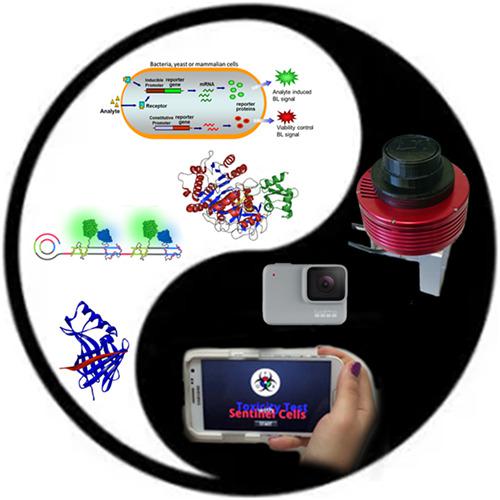当前位置:
X-MOL 学术
›
Luminescence
›
论文详情
Our official English website, www.x-mol.net, welcomes your
feedback! (Note: you will need to create a separate account there.)
Bioluminescence goes portable: recent advances in whole‐cell and cell‐free bioluminescence biosensors
Luminescence ( IF 3.2 ) Pub Date : 2020-09-17 , DOI: 10.1002/bio.3948 Antonia Lopreside 1 , Maria Maddalena Calabretta 1 , Laura Montali 1 , Martina Zangheri 1 , Massimo Guardigli 1, 2 , Mara Mirasoli 1, 2, 3 , Elisa Michelini 1, 2, 4
Luminescence ( IF 3.2 ) Pub Date : 2020-09-17 , DOI: 10.1002/bio.3948 Antonia Lopreside 1 , Maria Maddalena Calabretta 1 , Laura Montali 1 , Martina Zangheri 1 , Massimo Guardigli 1, 2 , Mara Mirasoli 1, 2, 3 , Elisa Michelini 1, 2, 4
Affiliation

|
Recent advancements in synthetic biology, organic chemistry, and computational models have allowed the application of bioluminescence in several fields, ranging from well established methods for detecting microbial contamination to in vivo imaging to track cancer and stem cells, from cell‐based assays to optogenetics. Moreover, thanks to recent technological progress in miniaturized and sensitive light detectors, such as photodiodes and imaging sensors, it is possible to implement laboratory‐based assays, such as cell‐based and enzymatic assays, into portable analytical devices for point‐of‐care and on‐site applications. This review highlights some recent advances in the development of whole‐cell and cell‐free bioluminescence biosensors with a glance on current challenges and different strategies that have been used to turn bioassays into biosensors with the required analytical performance. Critical issues and unsolved technical problems are also highlighted, to give the reader a taste of this fascinating and challenging field.
中文翻译:

生物发光变得可移植:全细胞和无细胞生物发光生物传感器的最新进展
合成生物学,有机化学和计算模型的最新进展已使生物发光在多个领域中得以应用,从建立完善的检测微生物污染的方法到体内成像以追踪癌症和干细胞,从基于细胞的测定到光遗传学。此外,由于在小型化和灵敏的光检测器(例如光电二极管和成像传感器)方面的最新技术进步,有可能将基于实验室的分析(例如基于细胞的分析和酶促分析)实施到便携式分析设备中,以实现即时医疗服务和现场应用程序。这篇综述着重介绍了全细胞和无细胞生物发光生物传感器的最新发展,同时展望了当前的挑战以及已采用的不同策略,将生物测定法转变为具有所需分析性能的生物传感器。还重点介绍了关键问题和未解决的技术问题,以使读者领略这个引人入胜且充满挑战的领域。
更新日期:2020-09-17
中文翻译:

生物发光变得可移植:全细胞和无细胞生物发光生物传感器的最新进展
合成生物学,有机化学和计算模型的最新进展已使生物发光在多个领域中得以应用,从建立完善的检测微生物污染的方法到体内成像以追踪癌症和干细胞,从基于细胞的测定到光遗传学。此外,由于在小型化和灵敏的光检测器(例如光电二极管和成像传感器)方面的最新技术进步,有可能将基于实验室的分析(例如基于细胞的分析和酶促分析)实施到便携式分析设备中,以实现即时医疗服务和现场应用程序。这篇综述着重介绍了全细胞和无细胞生物发光生物传感器的最新发展,同时展望了当前的挑战以及已采用的不同策略,将生物测定法转变为具有所需分析性能的生物传感器。还重点介绍了关键问题和未解决的技术问题,以使读者领略这个引人入胜且充满挑战的领域。











































 京公网安备 11010802027423号
京公网安备 11010802027423号